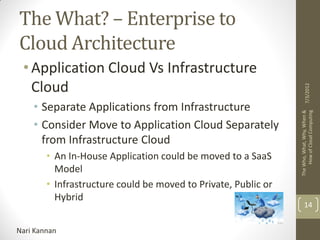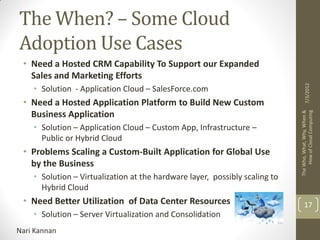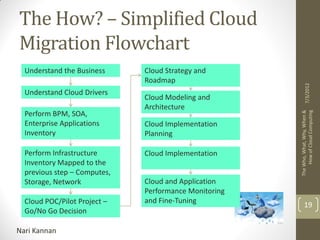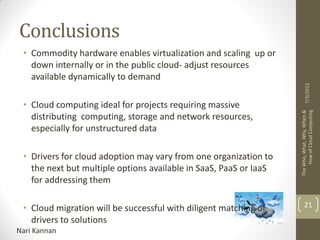The who, what, why, when & how of cloud computing
- 1. 7/3/2012 The Who, What, Why, When & The Who, What, Why, When & How of Cloud Computing How of Cloud Computing Nari Kannan 1 Nari Kannan
- 2. Agenda • Definition of Cloud Computing • The Who? • Evolution of Cloud Computing • Who’s Using Cloud Computing and For What? 7/3/2012 • The What? • Cloud Computing Models and Tools Available The Who, What, Why, When & How of Cloud Computing • Enterprise to Cloud Architecture • The Why? • Cloud Computing Drivers • Objections and Concerns • The When? – Some Cloud Adoption Use Cases • The How? • Simplified Cloud Migration Flowchart 2 • Conclusions Nari Kannan
- 3. Nari Kannan Definition of Cloud Computing The Who, What, Why, When & 7/3/2012 3 How of Cloud Computing
- 4. Definition of Cloud Computing • Best Definition I have seen so far: Cloud Computing is a style of computing where computing resources (Computes, Storage, Network, Computing Platforms , Applications) are 7/3/2012 easy to obtain, cheap and just work! • Characteristics: The Who, What, Why, When & How of Cloud Computing • Scalable & Reliable Software As A Service • Elastic (SaaS) • Ubiquitous Access Platform As A Service (PaaS) • Complete Virtualization • Relative Consistency Infrastructure As A Service (IaaS) • Commodity Hardware & Software • Measured Service • Multi-Tenant 4 • Multiple Applications Nari Kannan
- 5. Definition of Cloud Computing Private Cloud 7/3/2012 Public Cloud The Who, What, Why, When & How of Cloud Computing Hybrid Cloud 5 Nari Kannan Vertical or Community Cloud
- 6. The Who? – Evolution of Cloud Computing Earliest Known Hypervisor – 1965 – IBM 360/85 – One Half acted as IBM 360/85, Other Half - IBM 7085 (Wikipedia) 7/3/2012 The Who, What, Why, When & How of Cloud Computing Estimates of Google 6 Servers – 1.7 M+ in 12 Data Centers – Jan 2012 Nari Kannan
- 7. The Who? • Perfect Storm of Many Developments over a Decade! • Drive for Scale – Web and Social Media Growing Faster than 7/3/2012 Processing Capabilities! • Drive for Simplicity – Large Batch Jobs and Simplified Querying! – No need for extra baggage in OS, Storage – Stripped Down The Who, What, Why, When & How of Cloud Computing Technology! – Hadoop/MapReduce, Google File System, MongoDB, CouchDB, Cassandra and Riak Distributed Databases • Drive for Commodity, Cheap Hardware – Tens of Thousands of Inexpensive Servers Needed! • Inexpensive Multi-Core Processors – Good for Distributed Parallel Processing • Dropping prices and Increasing Storage Capacities • Faster Networks 7 Nari Kannan
- 8. Nari Kannan The Who? The Who, What, Why, When & 7/3/2012 8 How of Cloud Computing
- 9. The Who? – Who’s Using Cloud Computing and for what? IBM Survey of 110 7/3/2012 Companies using Cloud Computing – October 2010 The Who, What, Why, When & How of Cloud Computing 9 Nari Kannan
- 10. The Who? – Who’s Using Cloud Computing and for what? 7/3/2012 The Who, What, Why, When & How of Cloud Computing Source: Ahead in The Cloud – CSC Cloud Index 10 Dec 2011 Nari Kannan
- 11. The What? – Cloud Computing Models & Tools Available 7/3/2012 The Who, What, Why, When & How of Cloud Computing 11 Nari Kannan
- 12. The What? – Cloud Computing Models & Tools Available Cloud Services Cloud Provisioning & Orchestration • Amazon Web Services • EnStratus • Rackspace • OpsCode 7/3/2012 • Joyent • RightScale • OpsSource • HP Hybrid Delivery • GoGrid • CA Automation Suite for Clouds The Who, What, Why, When & How of Cloud Computing • Microsoft Azure Web Services • EMC Iconix • Terremark • BMC Cloud LifeCycle Management • Savvis • Eucalyptus (Open Source) • Fujitsu Cloud Services Cloud PaaS • VCE – VMWare, Cisco, EMC Virtualization Software • Kinvey • VMWare • Microsoft Hyper-V Cloud Monitoring • Citrix XEN Server • Hyperic 12 • XEN Server (Open Source) • CloudKick •OpNet Nari Kannan •Heroix
- 13. The What? – Enterprise to Cloud Architecture Business Process Management Layer 7/3/2012 Integration Layer – Service Oriented Architecture – External Enterprise Services The Who, What, Why, When & How of Cloud Computing Enterprise Applications Layer – In-House Applications, SaaS Applications, Social Media Cloud Layer – Orchestration, Provisioning, Auto-Scaling, New! Monitoring, Performance Hardware Layer – Computes, Storage, Network – Private, Public, Hybrid 13 Nari Kannan
- 14. The What? – Enterprise to Cloud Architecture • Application Cloud Vs Infrastructure Cloud 7/3/2012 • Separate Applications from Infrastructure The Who, What, Why, When & How of Cloud Computing • Consider Move to Application Cloud Separately from Infrastructure Cloud • An In-House Application could be moved to a SaaS Model • Infrastructure could be moved to Private, Public or Hybrid 14 Nari Kannan
- 15. The Why? - Cloud Computing Drivers • Better Asset Utilization (Infrastructure) • Better Asset Utilization (People and Skills) 7/3/2012 • Projects that Require Massive Scaling or Distributed Storage and Processing - Hadoop/MapReduce/Cassandra/Riak The Who, What, Why, When & How of Cloud Computing • Reduced /Optimized IT Cost – No need to buy additional hardware/software for one-time large scale projects • Conversion of Fixed Costs to Incremental Costs – Step-wise Fixed Costs to Smooth Variable Costs • IT Scaling Backlog Reduction (VMs on Hybrid Clouds – Even Business Groups Self-Service Possible) • Ideal model for New Startups or Intrapraneurial Ventures – Failure does not leave you with unused hardware and 15 software Nari Kannan
- 16. The Why? – Objections & Concerns • Security • Private Clouds – Can be as secure as before private clouds 7/3/2012 • Public Clouds – Providers have higher level of expertise and protection but need evaluation • Full Segregation on Public Clouds using Virtual Private Clouds The Who, What, Why, When & How of Cloud Computing • Vendor Lockin • Losing Control • Valid concern considering loss of visibility of where computes and storage are on public clouds at any time • Concerns about Data Leakage on Public Clouds also valid concern • Cost – Holistic calculations needed taking into effort people, hardware, software, time , effort 16 • Change and Disruption Nari Kannan
- 17. The When? – Some Cloud Adoption Use Cases • Need a Hosted CRM Capability To Support our Expanded Sales and Marketing Efforts 7/3/2012 • Solution - Application Cloud – SalesForce.com • Need a Hosted Application Platform to Build New Custom Business Application The Who, What, Why, When & How of Cloud Computing • Solution – Application Cloud – Custom App, Infrastructure – Public or Hybrid Cloud • Problems Scaling a Custom-Built Application for Global Use by the Business • Solution – Virtualization at the hardware layer, possibly scaling to Hybrid Cloud • Need Better Utilization of Data Center Resources 17 • Solution – Server Virtualization and Consolidation Nari Kannan
- 18. Nari Kannan The How? – Cloud Migration The Who, What, Why, When & 7/3/2012 18 How of Cloud Computing
- 19. The How? – Simplified Cloud Migration Flowchart Understand the Business Cloud Strategy and Roadmap 7/3/2012 Understand Cloud Drivers Cloud Modeling and Architecture The Who, What, Why, When & How of Cloud Computing Perform BPM, SOA, Enterprise Applications Cloud Implementation Inventory Planning Perform Infrastructure Cloud Implementation Inventory Mapped to the previous step – Computes, Storage, Network Cloud and Application Performance Monitoring Cloud POC/Pilot Project – and Fine-Tuning 19 Go/No Go Decision Nari Kannan
- 20. The How? – Best Pilot Candidates for Cloud Migration • Application Development and Test Virtual Machines • Training Applications 7/3/2012 • Mission Support Applications • Email, Collaboration Tools like Intranets The Who, What, Why, When & How of Cloud Computing • New Mobile applications that require rapid scaling, especially Consumer-facing • Phased Migration Strategy • Show ROI and Improved Server Utilization with Virtualization, Create and Prove a Private Cloud • Migrate to Hybrid Cloud for new projects and applications such as above • Plan for public cloud implementations for the 20 longer term Nari Kannan
- 21. Conclusions • Commodity hardware enables virtualization and scaling up or down internally or in the public cloud- adjust resources available dynamically to demand 7/3/2012 • Cloud computing ideal for projects requiring massive The Who, What, Why, When & How of Cloud Computing distributing computing, storage and network resources, especially for unstructured data • Drivers for cloud adoption may vary from one organization to the next but multiple options available in SaaS, PaaS or IaaS for addressing them • Cloud migration will be successful with diligent matching of 21 drivers to solutions Nari Kannan
- 22. Nari Kannan Conclusions The Who, What, Why, When & 7/3/2012 22 How of Cloud Computing
































































































